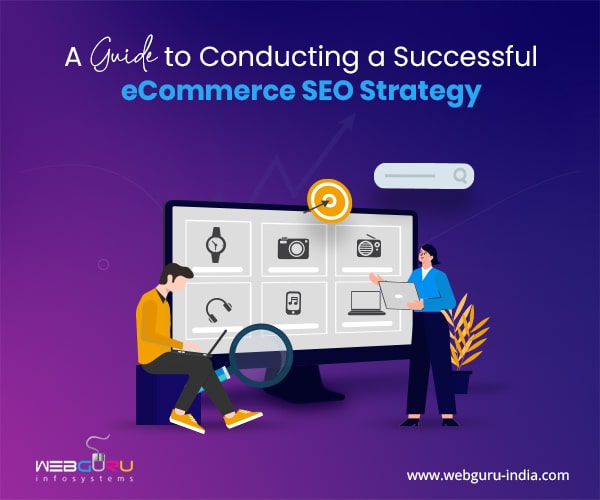Home Blog Website Development A Guide to a Successful eCommerce SEO Strategy
A Guide to a Successful eCommerce SEO Strategy
- 19 May / 2023
- 2,091 views
- 6 Min Read

As online shopping becomes popular, your eCommerce business needs to build a strong online presence. And to achieve success, you need to apply strategically planned SEO tactics. It can significantly enhance the visibility of your online store, attract targeted traffic, and increase sales. In this article, we will cover all the important practices of eCommerce SEO. We will also provide actionable tips that top SEO companies regularly use to boost businesses.
1. Conduct Keyword research
Creating a list of fitting keywords is key to building a sturdy SEO strategy. The keywords should correspond with your products/services, the audience you hope to attract, and the intent behind their search. Examine the keywords used by your competition, think of more detailed-worded phrases for particular commodities, and tap into the wide array of keyword research tools at your fingertips. Free tools like Google’s Keyword Planner and Ubersuggest are easy to use and can help you prepare a list of target keywords easily. You can also use professional SEO tools like Semrush or Ahrefs, which will allow access to competitor analysis as well.
In eCommerce SEO, using long-tail keywords is vital and provides numerous advantages. These phrases are highly detailed and precise, effectively capturing potential customer intent. Long-tail keywords often contain three or more words and are particularly specific to a niche, product, or category. Integrating these keywords into your SEO plan can help attract customers that are more likely to convert, resulting in targeted traffic.
Add a few related keywords also in your list. As you begin keying in the search box on Google, it automatically provides you with some related keywords. These suggestions are offered based on the search history of potential shoppers. In the SERP of Google, there is a segment called “People Also Ask”. This area provides you with some inquiries that pertain to your search term. Jazzing up your product description with these inquiries and providing an answer within the content will boost the visibility of your products.
Keep a watchful eye on search volume and difficulty level as you finalize keywords. Strive for a balance between these values, enabling a decent influx of traffic without a struggle to rank.
2. Optimize Product Titles, Descriptions, and Metadata
To optimize an eCommerce website, strategically incorporate keywords in various sections for better visibility and relevance. Use relevant keywords in product titles to help search engines understand what the products are about. Make use of descriptive language that accurately represents your product and piques potential customers’ interest.
You must create individual descriptions for each of your unique products that provide crucial information while still incorporating targeted keywords to fine-tune SERP visibility. If you can use keywords that are suitable for describing the features, benefits, and USPs of your products, their descriptions will also be organically optimized for search engines. Ensure that descriptions are appealing, and retain relevance while maintaining keyword consistency throughout. Don’t just stuff keywords – search engines might penalize you.
Meta tags play a vital role too; optimizing them leads to higher click-through rates since these tags appear on search engine results pages. Entice users by crafting compelling meta titles/descriptions that are concise and direct with themed targeted keywords outlining top-notch qualities and specs of the product.
3. Improve Site Architecture and Navigation
During your eCommerce website development make sure it is easy to use. Creating a website with straightforward navigation not only enhances the user experience, but also makes it easier for search engines to understand your site’s structure.
To establish a distinct and intuitively clean organization, look at the product categories and simplify them into smaller groups. However, don’t make it overwhelming through numerous categories and subcategories. Be sure each category is easily understandable while keeping related products within their respective group. Use breadcrumb navigation to provide easy navigation paths for users and search engines to navigate through your website.
Use a clear and user-friendly menu that displays your key categories prominently. Do not use intricate dropdown menus or complex navigating processes. The navigation must remain uniform throughout all pages and easy to access from any part of your website.
Finally, make sure there is plenty of internal linking between your pages. When you link your important pages to other pages on your site, you’re essentially signaling to search engines that these pages are relevant as well. Use proper anchor texts, with relevant keywords and phrases to the page you’re linking to. Your product pages will be a treasure trove of internal links. Link back to the category page, other similar category pages, recommended and related products, social media pages, and your blog posts on the specific product. However, don’t just add links at random. Link only to pages that are related, and it will help in navigation as well as SEO.
4. Boost Website Speed
Fast loading times on your site are critical for both user experience and search engine optimization. Optimize your eCommerce site’s loading speed by compressing images, minifying CSS and JavaScript files, and leveraging caching techniques. Use a reliable hosting provider and content delivery network (CDN) to ensure quick page loading times. A quicker website can enhance search rankings, increase customer engagement and reduce bounce rates. This can be a complex task, so you may consider hiring professional website design services.
5. Design For Mobile Devices
Everyone uses mobile devices today, and mobile-friendly sites are a must. Mobile shopping has also gained enormous traction over the last decade. Ensure that your eCommerce store is optimized for mobile devices by utilizing a responsive website design that effortlessly adjusts to varying screen sizes. As Google favors mobile-friendliness as a ranking factor, achieving this potentially increases the chances of appearing higher in mobile search results.
6. Develop Quality Content
Creating high-quality informative content is absolutely essential for eCommerce SEO. Feature appropriate and helpful information that is relevant to your products/services or your industry blogs. Make sure they are easy to access. By writing detailed product guides, tutorials, and buying guides to address common customer pain points, you can help them in making informed purchasing decisions. Incorporate crucial keywords into your blog naturally. Encouraging social sharing and backlinking also plays a significant role in expanding online reach.
7. Optimize For Local Search
If you’re running a physical store or targeting specific geographic locations, optimizing for local SEO is essential. Start by creating and optimizing your Google Business Profile, paying attention to location-specific metadata and keywords throughout your content. Encourage clients to provide feedback and reviews both on your site as well as via referral platforms. The implementation of such measures can improve your brand presence within the target area.
8. Build Quality Backlinks
To boost your site’s domain authority as well as its visibility in search results, focus on building quality backlinks rather than quantity. They hold a significant amount of weight in SEO. This involves participating in high-quality guest blogging opportunities or collaborating with bloggers who have influence within your specific industry. Entice them to create shareable natural content that invites more links back to yours.
9. Leverage Social Media
Efforts made on social media platforms play an extensive role in generating traffic to your eCommerce site. Promoting your products, blog content, and special offers through social media channels directs potential clients back to where they can engage your brand more. You can also encourage them to share such valuable content, providing increasing online visibility and reach.
Conclusion
To enhance the visibility of your online store and increase organic traffic, it is important to become proficient in eCommerce SEO. By following the valuable techniques outlined within this blog, you can optimize your website to rank better in search engine results and also increase sales.
Always administer thorough keyword research, write helpful product descriptions and metadata, strengthen the architecture and navigation of the site, prioritize swift page loading time, and prepare high-quality content. Don’t ignore the relevance of mobile-friendliness, local SEO, link-building, or taking advantage of social media. Applying a comprehensive and planned technique to your eCommerce SEO strategies can successfully position your digital retail space for successful growth and maximum revenues.
Have you tried applying SEO for your eCommerce website but with little or no success, then consider hiring a professional SEO agency for the best results.
1 comment
Leave a Reply

-
1000+
Happy
Clients -
25+
Countries
Served -
19+
Years of
Trust









Very well written blog. I appreciate the information you presented in the blog.